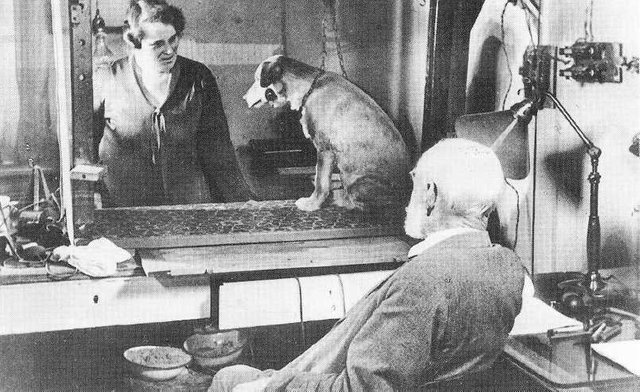Reprogramming yourself after abuse: How to love again.
How can survivors undo ritual abuse programming?
It is now well-established that trauma-based conditioning allows abusive groups to use rituals to effectively 'program' the human nervous system almost as if it were a computer. Pavlov (1849 – 1936) was one of the first scientists to demonstrate organic programming induced through classical conditioning.
Pavlov was, famously, able to program a dog to salivate in response to a bell that had previously signalled the arrival of food. Later, in the Little Albert Experiment, a wholly unethical study, it was demonstrated that a human child could easily be programmed. Later still, John C. Lily (1915 – 2001) developed the term 'human biocomputer'.

One of Pavlov's dogs
What is a Human Biocomputer?
You are a human biocomputer. The human biocomputer is a paradigm to describe your brain, body and nervous system. It surmises that, as humans, we are programmable, organic, machines. Despite considerable research in this area, and a growing canon of literature on the subject, mainstream awareness of this topic is very low. This may be because we do not like to regard ourselves as having been 'programmed' because this feels existentially bleak. However, it may not be as bleak at it first seems because with awareness of being programmed comes the opportunity to deprogram.
Awareness that you were programmed is the first step
It is painful to acknowledge that the first few years of your life installed the 'operating system' that you now unconsciously run on. But what is more painful is never waking up to this information. Almost every human has been programmed in one way or another by their early interactions with caregivers, and by general societal conditioning.
The programming that left its deepest scars will have taken place in your childhood when neuroplasticity in your brain was highest. This programming will be the hardest to see because it forms the very foundation of your perceptions of the world. Just as a fish may regard the shore of the ocean as the edge of the world, never knowing the land, you may have similar limitations installed in you by early programming.
In many cases, linguistic-emotional concepts like 'love' were attached by your programmers — typically your caregivers — to concepts that were dangerous or harmful. For example, your adult pursuit of love may be doomed until you establish that what you were told was love was, in fact, violence, control, ownership, abandonment and/or sexual abuse.
Often, this programming is done unconsciously by a caregiver. For example, an alcoholic father may not specifically intend that raping his child will set her up to unconsciously seek violent, alcoholic partners, but it will often have this effect none-the-less.
Intentional programming
Many caregivers are simply unconscious of how early conditioning determines the outcome of a child's entire life. However, some groups and organizations are deeply aware of the means by which a child can be programmed. They use this knowledge to intentionally install 'software' in the psyche of the developing child. You can read about some of the more common programs and the methods of their installation here: Ritual Abuse and Mind Control: The Manipulation of Attachment Needs
The many programming methods used are too varied and complex to cover here, but I have attempted to address some of them in previous posts. Many of them rely on basic classical conditioning (as described by Pavlov). But, for the purposes of this overview, we will look at one such program; how it is installed; and why it is difficult to detect and deprogram it.

Survivors programmed to attack those who help them
One of the most difficult things about supporting a survivor of ritual abuse as they deprogram themselves is that the they are likely to attack you — physically or emotionally — during the process. This is because you pose a threat to their internal system. In other words, if you begin to support a survivor in processing and deprogramming themselves, you begin to expose them to the pain of their original abuse.
The problem here is that, as a child, the survivor was programmed to do everything they could to avoid this pain in their core. In fact, this is the very essence of trauma-based programming. These programs rely on the fact that 'alters' or 'part selves' have been fragmented across the survivor's psyche. These alters either contain pain, or protect other alters that contain pain.
If an alter feels that a therapist or other compassionate person may release this pain, defences may step in and seek to destroy the therapist or supportive friend. By doing this, the survivor avoids feeling the unbearable pain of years of sexual abuse and torture. Typically, the survivor is not conscious of this mechanism and will rationalize her attack as being in response to some perceived slight.
How are alters programmed to attack?
Cults and other groups use complex set-ups and classical conditioning to program alters (or parts-selves) in the survivor's psyche to attack anyone who might help the survivor escape the cult or deprogram themselves. One way that a cult does this is as follows:
The child meets a newcomer who offers them help to escape the cult. They make plans together to leave. As they are 'escaping', the newcomer reveals themselves to actually be part of the cult. Then the child is tortured for accepting the help. Then this is repeated until the child learns to attack the offer of help to avoid the pain of the torture she fears will follow. Now the child is programmed to believe that any 'helper' is always a cult member in disguise and following them will result in torture.
In adulthood, this subconscious belief persists and the survivor will have alters in her psyche who seek to destroy anyone who gets close to facilitating their deprogramming. This attack will come either through violence, or emotional manipulation, or both.
This is why many survivors never make it out of the deprogramming stage. They will often attack anyone who offers genuine compassion and healing, while embracing anyone who distracts them from healing, or provides them with a sense of power and control to compensate for their core feeling of abandonment and loss.
Often this pattern of avoidance can go on for years: The survivor constantly seeking external validation and distraction in place of authentic healing. The survivor may not be therapy-averse, but will simply choose therapies that have no effect on the core problem, and ensure the ongoing protection of the cult.
In other words: many cult survivors have been programmed to be impossible to deprogram.
How can a survivor deprogram themselves?
As with many recovery programs, the first step is for the survivor to admit that they have a problem. However, it is extremely hard for a survivor to acknowledge they are distracting themselves from their pain, or that they are attacking those who seek to help them.
The problem is that the survivor will simply be unaware that they are doing this and will have rationalized their emotional manipulation as a natural impulse. Survivors of abuse can compensate for pain by attaining positions of 'power' or 'authority' in which they are admired, but ultimately this never heals the wound inside.
Survivors of ritual abuse may also cope with their anger at their abusers by displacing it onto vulnerable, empathic individuals, and attacking them. Again, this is preferable to speaking out about the cult, because the survivor has been programmed never to speak out against her abusers. Instead the survivor must mediate her anger through a process of regularly displacing it. In other words, she is like a kettle that must release steam in a violent outburst, but can never take itself off the oven (the original source of the heat), because the original source of this anger is the cult. And the cult has programmed her never to expose it.
Ritual abusers deeply program their victims never to report the crimes. And survivors will often find every rationalization not to speak out. This ongoing silence is the best indication that ritual abuse programs are still running in the survivor's psyche. The survivor will find no shortage of 'authority figures' (lawyers, doctors, psychologists) to reassure her that keeping silent is the best course of action. The objective of her internal system of alters is to protect the group who abused her. She has been programmed to do so through extreme torture as a child and will seek out those who support her silence.
It is only when the survivor asks themselves serious questions about whether they truly feel that their alter system is resolved that healing can continue. It also takes careful self-reflection and time away from their dependency on external-validation.
No amount of validation from the outside can fill the wound at the heart of a ritual abuse survivor. The path to true freedom requires walking the labyrinth all the way to the centre and knowing, for certain, that no more programming exists in the system.
At this point, the survivor can begin to program themselves and, for the first time, experience true love. That is: love that shines from inside, not love that seeks validation outside. For this was the original wound: that the child's love for herself was destroyed by the abusers. But, with gentleness, and thoughtfulness, it can grow again.
Speaking out
Ultimately, what was taken from the ritual abuse survivor was her voice. When she comes to find it again, and uses it to confront her abusers by speaking out, she heals herself and protects other vulnerable children. This process demonstrates that her empathy for both herself as a child, and her compassion for others is restored. In speaking out she finally speaks for the child she once was. The bond between the wounded child and the adult survivor, who can now speak for her, is restored.
At this point, the inner child inside the survivor finally hears the message she could never hear when she was being abused: You matter to me; I care; I speak for you; I want you to be free.
In other words: Speaking out does not come after healing. Speaking out is the healing.
It is also a sign that the survivor has finally left the cult and finished the deprogramming process. She has now broken their primary instruction to her while she was being raped, tortured and programmed: Never tell anyone about this.
In speaking out, she discovers that they no longer control her, and she is free.
To quote from Sarah's speech at the end of the movie, The Labyrinth:
"Through dangers untold and hardships unnumbered, I have fought my way here... to take back the child that you have stolen, for my will is as strong as yours, and my kingdom as great — You have no power over me."
Further reading:
Healing the Unimaginable: Treating Ritual Abuse and Mind Control
Trauma and the Soul: A Psycho-Spiritual Approach to Human Development and Its Interruption
The Inner World of Trauma: Archetypal Defences of the Personal Spirit
Bravo @kida, very eloquently and clearly laid out.
Resteemed with love and respect!
🚣